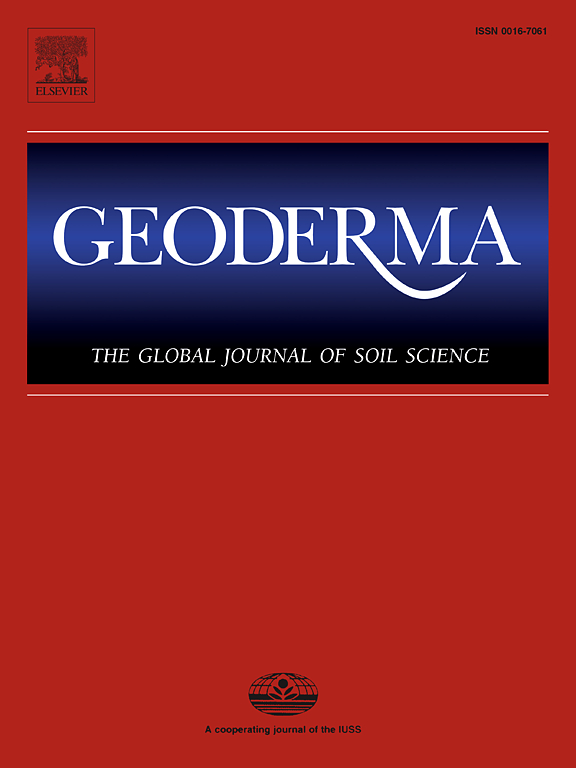对原位土壤pH传感器数据的独立校准:空间和时间接近的相关性,样本量和数据传播对校准模型性能的影响
IF 6.6
1区 农林科学
Q1 SOIL SCIENCE
引用次数: 0
摘要
近端土壤遥感数据通常需要校准以提取有意义的信息,例如用于精准农业。为了获得最佳应用,校准建模通常基于从现场采样收集的参考数据。然而,这种方法既不省时也不划算,并且阻碍了近端土壤遥感在实际农业中的应用。因此,尽量减少校准采样是必要的。对于精准农业中的pH测绘,我们研究了参考采样是否可以减少校准工作,因为参考采样对位置和时间的依赖较少。这项研究使用了612个传感器和来自德国东北部两个农场的62块田地的标准实验室pH测量值。我们评估了时空接近、样本量和数据分布对pH传感器数据校准单变量线性回归模型性能的影响。此外,在区域、农场、空间邻域(NH)、时间NH和场(v)五个层次上分析了非站点独立定标的性能。这种多层次的方法旨在评估校准模型的泛化性。偏相关分析表明,样本量是优化模型性能的最关键因素。现场校准的平均RMSE比区域、农场或社区模型低34%,但需要最多的参考样本。相比之下,社区模型减少了大约74%的样本量,农场模型减少了87%,区域模型减少了86%,同时获得了相似的均方根误差。因此,在实际的精准农业中,农场或区域模型可以显著减少采样的工作量和成本。pH值的扩散是影响模型性能的第二个重要因素。选择用于校准的传感器测量值的pH范围应大于1个单位,以获得高质量的校准模型。最后,空间和时间色散对标定性能的影响最小。本文章由计算机程序翻译,如有差异,请以英文原文为准。
Towards site-independent calibration of in situ soil pH sensor data: Relevance of spatial and temporal proximity, sample size and data spread for calibration model performance
Proximal soil sensing data usually require calibration to extract meaningful information, e.g. for precision agriculture. For optimal application, calibration modeling is typically based on reference data collected from field-wise sampling. However, this approach is neither time- nor cost-effective and hinders the adoption of proximal soil sensing in practical agriculture. Thus, minimizing calibration sampling is essential.
For the case of pH mapping in precision agriculture, we have investigated whether calibration efforts can be reduced by reference sampling, which is less dependent on location and timing. This study utilized 612 sensor and standard lab pH measurements from 62 fields of two farms in Northeast Germany. We assess the effects of spatial and temporal proximity, sample size and data spread on the performance of univariate linear regression models for pH sensor data calibration. Moreover, the performance of site-independent calibration was analyzed for five domain levels: (i) regional, (ii) farm, (iii) spatial neighborhood (NH), (iv) temporal NH and (v) field. This multi-level approach aims at assessing the generalizability of calibration models.
Partial correlation analysis revealed that sample size is the most crucial factor for optimizing model performance. Field-wise calibration yielded a 34 % lower mean RMSE than regional, farm, or neighborhood models but required the most reference samples. In contrast, neighborhood models reduced sample size by approximately 74 %, farm models by 87 % and the regional model by 86 %, while achieving similar RMSEs. Thus, farm or regional models can significantly reduce sampling effort and costs in practical precision agriculture. The spread of the pH value was the next important factor influencing model performance. The pH range in the sensor measurements selected for calibration should be larger than 1 unit to obtain good quality calibration models. Finally, spatial and temporal dispersion had the least effect on calibration performance.
求助全文
通过发布文献求助,成功后即可免费获取论文全文。
去求助
来源期刊

Geoderma
农林科学-土壤科学
CiteScore
11.80
自引率
6.60%
发文量
597
审稿时长
58 days
期刊介绍:
Geoderma - the global journal of soil science - welcomes authors, readers and soil research from all parts of the world, encourages worldwide soil studies, and embraces all aspects of soil science and its associated pedagogy. The journal particularly welcomes interdisciplinary work focusing on dynamic soil processes and functions across space and time.
 求助内容:
求助内容: 应助结果提醒方式:
应助结果提醒方式:


